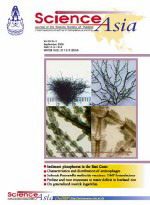ThaiScience
ThaiScience
SCIENCE ASIA
Volume 46, No. 05, Month OCTOBER, Year 2020, Pages 503 - 513
Transcriptome profiling to understand host-bacteria interactions past, present and future
Sheila Nathan
Abstract Download PDF
Despite advances in antimicrobials, vaccination and public health measures, bacterial infectious diseases remain a leading cause of morbidity and mortality worldwide. With the increase in antimicrobial resistance and the emergence of new bacterial pathogens, there remains a need for better understanding of the host response to infection. This would lead to new paths of basic research and the identification of potential diagnostic biomarkers and new drug targets to overcome issues of antibiotic resistance. Bacterial pathogens have evolved strategies to promote their survival by significantly over-riding the transcriptional profile of the host cells they infect. In particular, pathogen-encoded effector molecules modulate host cells through different mechanisms. Transcriptomics is a powerful way to gauge these changes in mechanism of either bacterial or eukaryotic cells under a given condition. Microarray technology and more recently RNA sequencing are well established tools to unravel host-pathogen interactions which is of central importance to understand the host response to a particular bacterial infection or the mechanisms employed by a pathogenic bacteria to subvert host defenses. The establishment of dual RNA-sequencing has enabled the profiling of gene expression changes simultaneously in an infecting bacterium and its infected host. This technology is able to provide greater discriminative power to study the pathogen and host simultaneously throughout the infection process. This review provides an overview of the transcriptome-based tools utilised and new knowledge obtained from dissecting hostpathogen interactions.
Keywords
transcriptome, dual RNA-sequencing, single cell RNA sequencing, Burkholderia pseudomalleiSCIENCE ASIA
Published by : The Science Society of Thailand
Contributions welcome at : http://www.scienceasia.org/
